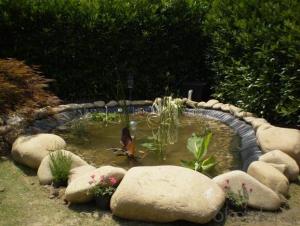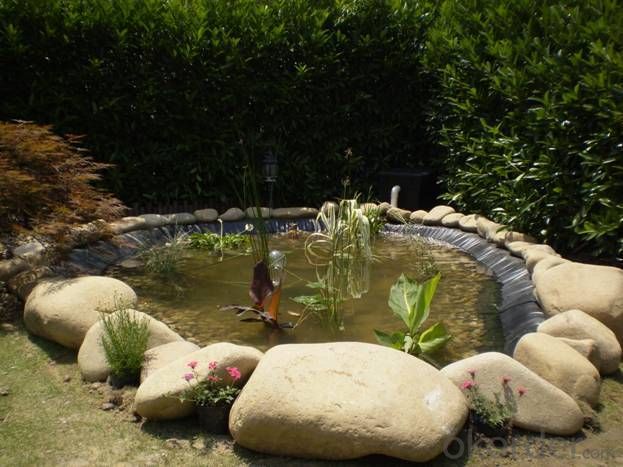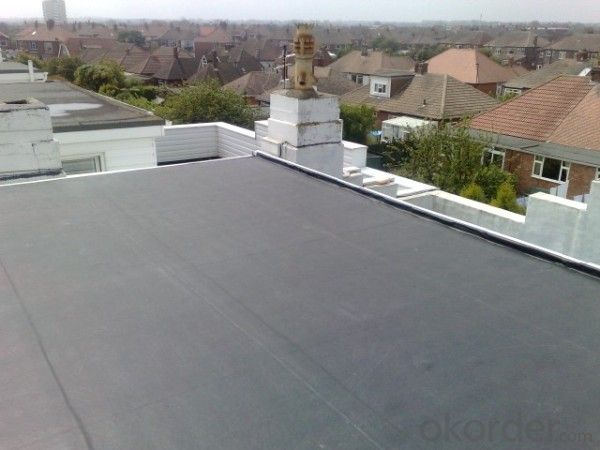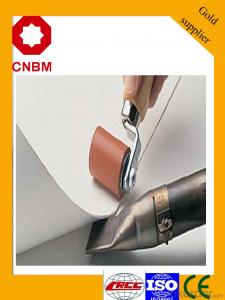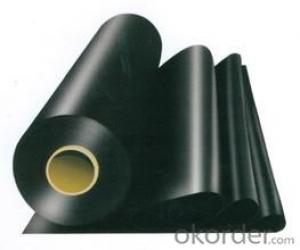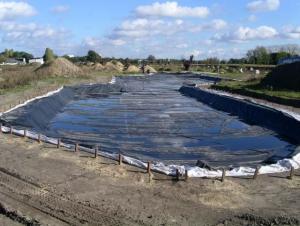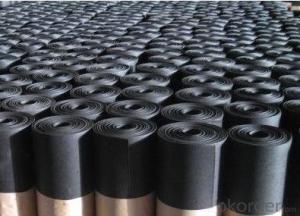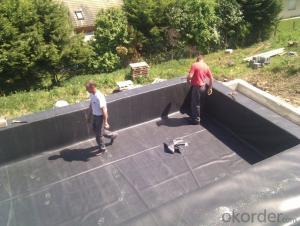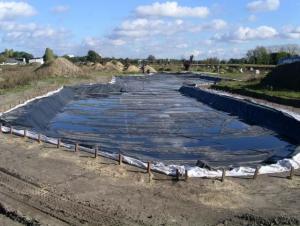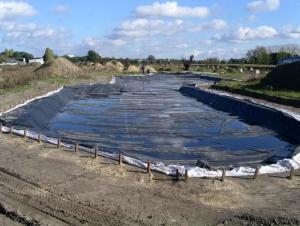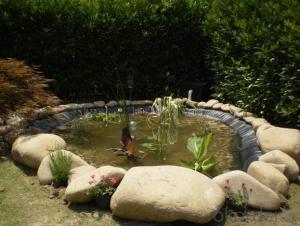EPDM Coiled Rubber Waterproof Membrane for Small Pond
- Loading Port:
- Shanghai
- Payment Terms:
- TT OR LC
- Min Order Qty:
- 20000 m²
- Supply Capability:
- 5000000 m²/month
OKorder Service Pledge
OKorder Financial Service
You Might Also Like
EPDM Coiled Rubber Waterproof Membrane for Small Pond
Description Of EPDM Coiled Rubber Waterproof Membrane for Small Pond:
This waterproof coiled material is of high elasticity with best performance among high polumer
waterproof coiled material in the world.It is also the most typical one in the world.Waterproof coiled material made of ternary ethylene-propylene rubber is produced withthe use of the most advanced contiuous extrusion and vulcanization technology and related equipments which are specially designed for production of such product.It is good in compactness,without bubble and performance difference in length and breadth,perfomances reach or exceedthe demands of GB18173.1-2000 standard.
Main Features of EPDM Coiled Rubber Waterproof Membrane for Small Pond:
A.Polyester based SBS Modified Bitumen Waterproofing Membrane
a. Strong impermeability
b. High tensile strength, elongation, ability to adapt the grassroots shrinkage deformation and cracking
c. Puncture-resistant, broken resistant, tear-resistant
d. The corrosion resistance, resistance to mildew, weathering good
e. Construction convenient, hot-melt can be operated Four Seasons Construction, reliable joints
B. Fiberglass based SBS Modified Bitumen Waterproofing Membrane
a. High tensile strength, stability of a good size
b. High Temperature good performance
c. Damage resistance, corrosion resistance, resistance to mildew, weathering good performance
d. Good construction performance, reliable joints.
Specifications of EPDM Coiled Rubber Waterproof Membrane for Small Pond:
| Material | EPDM Rubber |
| Size | 1.2m (width)*20m (length) or customized, weldable type 2.05m or 4m width |
| Thick | 1.2mm, 1.5mm, 2.0mm |
| Type | Vulcanized & Weldable |
| Pattern | Non-reinforced (homogeneous) |
| Certificate | ISO9001/14001 |
Applications of EPDM Coiled Rubber Waterproof Membrane for Small Pond:
1. Good ability of anti-aging, resistant to high and low temperature. High tensile strength and enlongation, which adapts to the contraction or crack of the base. Make sure the base surface smooth, clean and dry(Moisture<9%), then paint the delicated agent on the base surface. Start application till it is dry.
2. Reinforce the parts which are easy to leak, such as seam, hole, channel, wall, pipe and corner.
3. Application Method:Lay the membrane directly. Be careful to control the overlaps of the long side and short side.
4. After application, a careful inspection is required. Make sure there is no air bubble, no fold, no falling away etc to guarantee the waterproof life.



IMages of EPDM Coiled Rubber Waterproof Membrane for Small Pond:




FAQ of EPDM Coiled Rubber Waterproof Membrane for Small Pond:
1. What are we supplying?
We are specialized in producing Colorful Asphalt Roof Shingle, SBS/APP modified bitumen waterproof membrane, Self adhesive bitumen waterproof membrane, PVC waterproofing membrane, EPDM rubber roofing membrane, Single Component Polyurethane Waterproof Coating, and Spray Polyurea Waterproof Coating
.
2. How Many years experience do we have?
We have been exported to more than 20 countries in the past 15 years.
3. How long do we usually reply your request?
We always reply our customer within 24 hours.
- Q: Can a waterproofing membrane be used on glass surfaces?
- No, a waterproofing membrane cannot be used on glass surfaces.
- Q: Are waterproofing membranes resistant to water vapor transmission?
- Yes, waterproofing membranes are designed to be resistant to water vapor transmission. They are specifically engineered to prevent the penetration of water vapor through the membrane, ensuring effective waterproofing and moisture control.
- Q: Do waterproofing membranes require maintenance?
- Maintenance is required for waterproofing membranes. Although they are designed to protect against water damage for a long time, regular maintenance is necessary to ensure their effectiveness. Cracks, tears, or other types of damage may develop over time, which can compromise the membrane's ability to resist water. Additionally, debris, dirt, and other substances may accumulate on the membrane's surface, blocking drainage and causing water to accumulate. Therefore, it is essential to regularly inspect the membrane and promptly address any issues. This may involve cleaning the surface, repairing or replacing damaged sections, and sealing seams or joints to maintain a barrier that is watertight. Regular maintenance not only extends the lifespan of the waterproofing membrane but also helps prevent expensive water damage to the underlying structure.
- Q: Does a waterproofing membrane prevent water infiltration through concrete or other building materials?
- Yes, a waterproofing membrane is designed to prevent water infiltration through concrete or other building materials. It acts as a protective barrier that is applied to the surface of the material, forming a water-resistant layer. This membrane can be made from various materials such as bitumen, rubberized asphalt, or liquid polymers. When properly installed, it can effectively prevent water from seeping through the concrete or other building materials, thus protecting the structure from potential water damage or moisture-related issues.
- Q: How does a waterproofing membrane adhere to the surface?
- A waterproofing membrane adheres to the surface through various methods such as mechanical attachment, adhesive bonding, or heat welding. Mechanical attachment involves physically securing the membrane to the surface using fasteners, nails, or screws. Adhesive bonding utilizes a waterproofing adhesive to create a strong bond between the membrane and the surface. Heat welding involves melting the membrane's surface and fusing it with the substrate, creating a watertight seal. The specific method used depends on the type of membrane and the surface to which it is being applied.
- Q: Can a waterproofing membrane be used for a basement floor slab?
- A basement floor slab can indeed benefit from the use of a waterproofing membrane. Its purpose is to hinder the infiltration of water and moisture into the surface to which it is applied. This solution is highly effective in shielding basement floor slabs against potential water damage. By applying a waterproofing membrane to the basement floor slab, you can establish a barrier that effectively obstructs water from penetrating, thus diminishing the likelihood of water damage, mold growth, and structural problems. Moreover, a waterproofing membrane can also function as a vapor barrier, preventing moisture from rising through the slab and causing issues like dampness or excessive humidity levels in the basement. All in all, selecting a waterproofing membrane for a basement floor slab is a wise decision that guarantees long-term durability and protection for the basement.
- Q: Can a waterproofing membrane be used in earthquake-prone areas?
- Using a waterproofing membrane in areas prone to earthquakes is not only possible but highly advisable. This is because it serves as an effective shield against water infiltration, which can cause significant harm to buildings and structures during seismic events. The main purpose of waterproofing membranes is to create a barrier that prevents water from seeping in, thereby safeguarding the structural integrity of a building. Moreover, these membranes possess some degree of flexibility and elasticity, allowing them to absorb and distribute the forces exerted during an earthquake. This reduces the likelihood of cracks and leaks occurring. Nonetheless, it is crucial to ensure that the waterproofing membrane chosen is specifically designed and tested to meet the requirements of earthquake-prone areas. Factors such as the intensity and frequency of seismic activity in the region should be taken into account. Seeking advice from a structural engineer or waterproofing specialist is highly recommended to identify the most suitable waterproofing system for earthquake-prone areas.
- Q: Can a waterproofing membrane be used in areas with seismic activity?
- Yes, a waterproofing membrane can be used in areas with seismic activity. Waterproofing membranes are designed to provide a protective barrier against water infiltration, and they can be applied to various surfaces including those in seismic-prone regions. However, it is important to consider the specific requirements and recommendations of the manufacturer and consult with structural engineers to ensure that the membrane and its installation are suitable and compliant with seismic design considerations.
- Q: Can a waterproofing membrane be used for soundproofing purposes?
- Yes, a waterproofing membrane can be used for soundproofing purposes to some extent. While its primary function is to prevent water penetration, it can also help to reduce sound transmission. Waterproofing membranes are typically made of materials that have good acoustic properties, such as rubber or a combination of rubber and asphalt. These materials can absorb and dampen sound waves, thereby reducing the amount of noise that passes through a wall or floor. However, it is important to note that the soundproofing effectiveness of a waterproofing membrane may not be as high as that of specialized soundproofing materials like acoustic panels or insulation. Therefore, if soundproofing is the main goal, it is recommended to consider using dedicated soundproofing solutions in addition to or instead of a waterproofing membrane.
- Q: Are waterproofing membranes suitable for wastewater treatment plants?
- Yes, waterproofing membranes are suitable for wastewater treatment plants. Wastewater treatment plants deal with the treatment and processing of wastewater, which contains a variety of chemicals, contaminants, and bacteria. These substances can be highly corrosive and can cause damage to the infrastructure of the plant if not properly protected. Waterproofing membranes provide an effective barrier against water and chemical penetration, preventing leaks, seepage, and corrosion. They can be applied to various areas of the plant, including tanks, basins, pipelines, and concrete structures. Additionally, waterproofing membranes are durable, long-lasting, and can withstand the harsh conditions and chemicals present in wastewater treatment plants. Therefore, using waterproofing membranes in wastewater treatment plants is a recommended practice to ensure the integrity, longevity, and efficiency of the infrastructure.
Send your message to us
EPDM Coiled Rubber Waterproof Membrane for Small Pond
- Loading Port:
- Shanghai
- Payment Terms:
- TT OR LC
- Min Order Qty:
- 20000 m²
- Supply Capability:
- 5000000 m²/month
OKorder Service Pledge
OKorder Financial Service
Similar products
Hot products
Hot Searches
Related keywords
